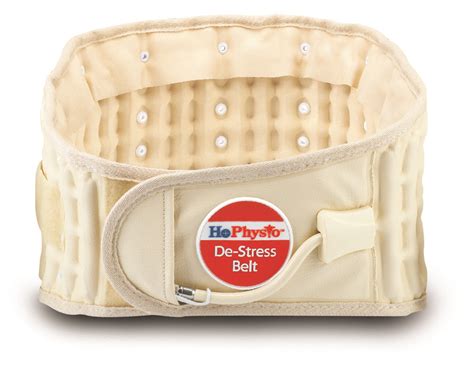What is DR-HO's Decompression Back Belt?

DR-HO's Decompression Back Belt is a revolutionary product that has helped people find relief from lower back pain. The belt is designed to provide spinal decompression, which involves gently stretching the spine to relieve pressure and promote healing.
The belt is made of high-quality, durable materials that can withstand regular use. It is adjustable, so it can fit people of different sizes comfortably. Additionally, the belt is lightweight and easy to wear, so you can wear it while performing everyday activities.
The Decompression Back Belt works by using a hand pump to inflate individual air chambers in the belt. As each chamber inflates, it creates a gentle and comfortable stretch on the lower back muscles and spinal column. As a result, any build-up of pressure on the discs and nerves is relieved, allowing for better circulation and, in turn, promoting healing.
The belt is suitable for people who have lower back pain caused by various conditions, such as herniated discs, spinal stenosis, degenerative disc disorder, and more. The gentle stretching provided by the Decompression Back Belt can help to reduce the pain associated with these conditions while encouraging healing.
One of the best things about DR-HO's Decompression Back Belt is that it is a non-invasive solution to back pain. Unlike surgery or injections, which can be expensive and require time off work, the belt is an affordable and convenient option. Moreover, wearing the belt regularly can help prevent future back pain and improve overall posture.
Overall, DR-HO's Decompression Back Belt is an excellent product for anyone looking to find relief from lower back pain. With its easy-to-use design, non-invasive approach, and proven track record, it is the perfect solution for anyone looking to improve their quality of life.
Frequently Asked Questions about dr-ho's decompression back belt
So that this can expand because they create this vacuum inside your discs and because of that your nerve will not be pinched. And then you have less pain. Okay. So this is very important.
The Lumbar Decompression Belt helps stretch and creates traction in the lower back. This gentle motion works to lengthen the spine and release worn-out discs from pressure. It also allows better blood, oxygen, and nutrient flow to reduce inflammation around the discs and sciatic nerve.
Research has NOT conclusively shown that back support belts are helpful in dealing with existing back pain or in preventing future injuries from happening.
Decompression back braces, such as the Elite Air Decompression LSO, are best for “true sciatica.” They involve a combination of traditional rigid low back support with a decompression belt. The rigid structures provide support while the decompression feature expands the lumbar (low back) belt.
This treatment can promote the healing of spinal disc tissue, and when it is coupled with positive lifestyle changes, such as losing weight, the pain-relieving benefits of spinal decompression can be maximized. Due to its non-invasive nature, spinal decompression is safe for young, middle-aged, or older men and women.
In simple terms, it would be safe to say that Spinal Decompression Therapy is a safe and effective alternative to surgical decompression to provide relief from back pain.
It is estimated that roughly one in every five patients will start to experience some form of pain relief within the first week. Moreover, two in every five patients will start to experience some significant relief from pain within the first two to three weeks.
Frequently Asked Questions About Spinal Decompression Therapy. Does spinal decompression work long term? Yes, spinal decompression becomes more effective over the course of continuous treatment. Many patients experience pain relief lasting up to a year following their final spinal decompression treatment.
Skin lesions. Improperly fitting belts, such as those marked one-size-fits-all, can cause skin irritation and lesions. Muscle atrophy. Long-term use of back support belts can lead to muscle atrophy, setting up your spine for injury later.
Muscle tension and strain.
Additionally, heat from the brace can help relax tense muscles, contributing to pain relief. A back brace for muscle injury or weakness is generally not recommended for longer than 2 to 4 days.
Decompression Therapy Can Help Your Spine Heal From Chronic Pain. Some treatments only address acute flare-ups, but spinal decompression also tackles chronic pain. That's because it addresses the cause of your pain, not just the symptoms. This helps your body heal itself without surgery or other invasive procedures.
Sacroiliac (SI) Belts
Sacroiliac belts are useful for sciatica pain that results from sacroiliac joint dysfunction. These belts provide direct compression to stabilize the sacroiliac joints. They restrict the movements of the sacroiliac joint which may irritate or pinch the sciatic nerve.
What Are the Side Effects of Spinal Decompression?
- Muscle soreness. Patients may feel mild muscle soreness or discomfort after the session.
- Numbness or tingling. Patients may feel numbness or tingling sensations in the legs or arms.
- Headache. Some patients may feel a mild headache after the treatment.
Decompression therapy is considered an effective treatment for pain caused by compressed nerves that's severe or chronic and disrupts your daily life.
Spinal Decompression Surgery
This could cause a cerebrospinal fluid leak which can cause neurological impairment. It is also very possible that the spinal cord and nerve roots could be jeopardized resulting in a loss or impairment of sensory or motor function.
Walking is a good way to keep active, but you should avoid heavy lifting, awkward twisting and leaning when you do everyday tasks until you're feeling better. You may be asked to return to hospital for one or more follow-up appointments in the weeks after your operation to check how you're doing.














